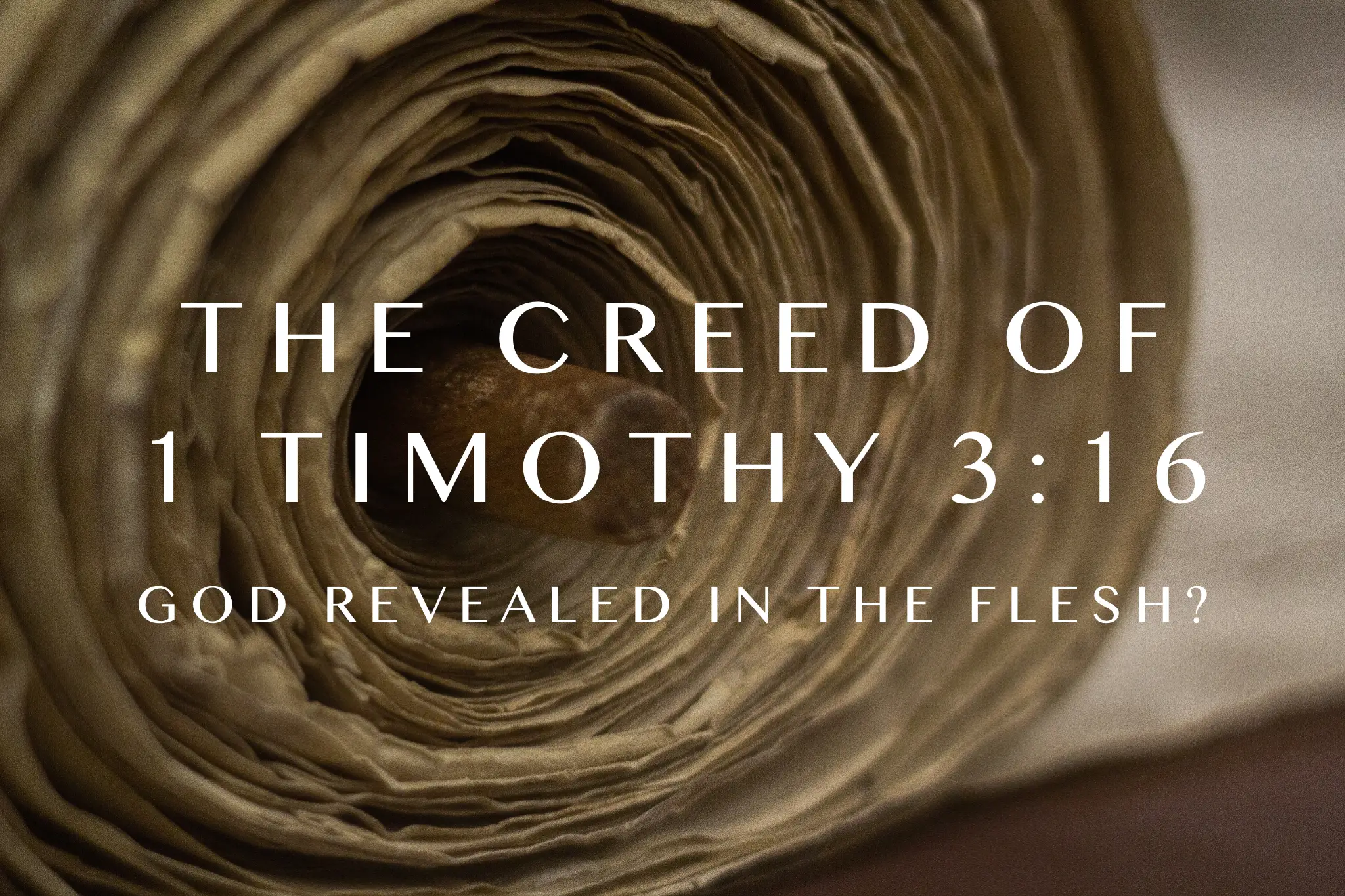There are many examples in Scripture of what scholars consider to be the earliest creeds, that is, concise statements of faith. For example, Moses taught the Jews that God is one:
Deuteronomy 6:4 (NASB) “Hear, O Israel! The LORD is our God, the LORD is one!
This foundational creed is known as the Shema because the first word of the creed in Hebrew is shema (or shama), which means to hear. Jesus adhered to this creed and said that to love this singular God was the foremost commandment.[1]
Another early creed, and the one which we will examine in this post, is found in Paul’s first letter to Timothy:
1 Timothy 3:16 (NASB) By common confession, great is the mystery of godliness: He who was revealed in the flesh, Was vindicated in the Spirit, Seen by angels, Proclaimed among the nations, Believed on in the world, Taken up in glory.
Some interpret this passage to mean that the mystery of God’s incarnation has been revealed. This viewpoint is strengthened for those who read the passage in the King James Version:
1 Timothy 3:16 (KJV) And without controversy great is the mystery of godliness: God was manifest in the flesh, justified in the Spirit, seen of angels, preached unto the Gentiles, believed on in the world, received up into glory. (emphasis added)
But is this what “common confessors” of the first century would have understood it to mean? We will examine the creed, as well as the context of Paul’s letter, to arrive at the proper interpretation.
Great is the Mystery of Godliness
In chapter three, Paul explains that his purpose in writing to Timothy about the qualifications for those desiring to be in Church leadership was so that one might know how to conduct oneself in the household of God. Paul goes on to describe the Church as the “pillar and support of the truth.”[2] The apostle then delivers what he describes as a common confession:
1 Timothy 3:16 (NASB) By common confession, great is the mystery of godliness: He who was revealed in the flesh, Was vindicated in the Spirit, Seen by angels, Proclaimed among the nations, Believed on in the world, Taken up in glory.
Those who adhere to a belief in a tri-personal God, when confronted with the myriad of contradictions inherent in the doctrine, often respond by saying it is a mystery that cannot be fully explained but must simply be accepted and believed in order to be saved. Thus, some rush to interpret the phrase great is the mystery of godliness as a reference to the mysterious doctrine of the Trinitarian Godhead. But neither the Greek text nor the English translations use the word Trinity or Godhead in this passage. Instead, Paul uses the word godliness, or eusebeia in Greek, which means godliness or piety. The apostle uses this word an impressive nine times in this epistle alone to describe Christians whose pious behavior exemplifies their devotion to God. Thus, when speaking about the mystery of godliness, Paul is referring to the means by which one is made pious or righteous before God, that is, by faith in Jesus as the Christ whom God sent.

Paul also wrote to the church in Rome about the mystery that had been revealed and how it had resulted in obedient faith:
Romans 16:25-27 (NASB) Now to Him who is able to establish you according to my gospel and the preaching of Jesus Christ, according to the revelation of the mystery which has been kept secret for long ages past, 26 but now is manifested, and by the Scriptures of the prophets, according to the commandment of the eternal God, has been made known to all the nations, leading to obedience of faith; 27 to the only wise God, through Jesus Christ, be the glory forever. Amen. (emphasis added)
Here Paul glorifies the only wise God as someone separate and apart from Jesus, who is the Christ, and through whom the mystery was manifested or revealed. One commentator explains:
…the term mystery is employed in the Christian Scriptures to signify, not those doctrines which are above the comprehension of the human mind, but the great truths of the gospel, which were promulgated in the Gentile world, and which, before the advent of the Saviour [sic], were a “mystery,” or secret, in consequences of their having been hidden from the view of mankind, but which ceased to be mysterious or concealed as soon as they were made known by Christ and the apostles.[3]
In other words, the mystery Paul speaks of has nothing to do with a triune-God or a God who became flesh, but that the one God of Israel would make a way for Jews and Gentiles to come into His kingdom through faith in His chosen Messiah.[4]
He Who Was Revealed in the Flesh
The second phrase that is often quoted as a so called proof text to support the belief that Jesus pre-existed as God, is He who was revealed in the flesh:
1 Timothy 3:16 (NASB) By common confession, great is the mystery of godliness: He who was revealed in the flesh, Was vindicated in the Spirit, Seen by angels, Proclaimed among the nations, Believed on in the world, Taken up in glory. (emphasis added)
Some quote the King James Version of the Bible, which, instead of saying He who was revealed in the flesh, says God was manifest in the flesh. Trinitarian scholars, however, attest to the fact that here the King James translation is a corrupted rendering of certain Greek manuscripts. They contend that the earliest and best manuscripts read, “He who was revealed in the flesh.” For example, Bruce Metzger, Biblical scholar and well-respected translator, writes:
[He who] is supported by the earliest and best uncials…no uncial (in the first hand) earlier than the eighth or ninth century supports theos [God]; all ancient versions presuppose hos or ho [“he who” or “he”]; and no patristic writer prior to the last third of the fourth century testifies to the reading theos. The reading theos arose either(a) accidentally, or (b) deliberately, either to supply a substantive for the following six verbs [the six verbs that follow in the verse], or, with less probability, to provide greater dogmatic precision [i.e., to produce a verse that more clearly supports the Trinitarian position].”[5]

Sir Anthony Buzzard favors the explanation that the text was later purposefully altered to support the doctrine of the Trinity. He explains how it could have happened:
Another example of a text which was altered is 1 Timothy 3:16. This verse reads in the KJV: “God was manifested in the flesh .” Modern versions have corrected the word “God” to “He who.” The alteration of an original “He who” (in Greek Ος) was very sneakily accomplished when some scribes changed the O (omicron) into a θ (theta) giving θς (theta sigma). The reading THS was an abbreviated form of the Greek word theos, God. All that had to be done was to draw a little line across the middle of the O to produce the Greek letter theta (θ). Then the text was made to sound Trinitarian and to support the Incarnation: “God was manifested in the flesh.” “He who” (Oς) was made to read “God” (θς).[6]
Regardless of whether the alteration was accidental or intentional, translators today almost unanimously agree that He who or He was revealed in the flesh is the correct translation.[7]
What Does It Mean?
If 1 Timothy 3:16 does not say that God was manifested in the flesh, and therefore, does not attest to the incarnation of deity, what then does it mean? Notice that the text does not say that Jesus was “made flesh” or that he “became flesh,” rather that his flesh or humanity was revealed. If Paul’s aim was to teach that Jesus was incarnated, he could have easily written, “He who was incarnated in the flesh…” but he didn’t. Rather, Paul writes that Jesus was revealed in the flesh.
The word revealed here in Greek is phaneroó,[8] and it means: to make visible, to make clear. Why would it have been important for this first century creed to emphasize that Jesus’ humanity had been made visible or that is was clear? Such a declaration could have been made in order to combat first century cultic beliefs held by Docetists and Gnostics. Docetism, from the Greek dokein, to seem, holds to the belief that Jesus only seemed to have had a human body. Gnosticism taught that all matter was evil, thus, Jesus would not have had a human body. Both Paul and John appear to be combating these false views when they emphasize Jesus’ body in a number of passages.[9] For example, John wrote about the importance of confessing that Jesus came in the flesh:
1 John 4:1-2 (NASB) Beloved, do not believe every spirit, but test the spirits to see whether they are from God, because many false prophets have gone out into the world. 2 By this you know the Spirit of God: every spirit that confesses that Jesus Christ has come in the flesh is from God; (emphasis added)
First, note that John writes that Jesus, who came in the flesh, is from God, not that he is God or that he is God in the flesh. Something he certainly could have written if that was his intent.
Second, from the text, we learn that false prophets had been deceiving people, presumably, by saying that Jesus had not come in the flesh. According to A.T. Robertson, the phrase to come in the flesh is an idiom referring to one’s humanity. He explains that, according to the grammar, the text
…describes Jesus as already come in the flesh (his actual humanity, not a phantom body as the Docetic Gnostics held)… [10]
This same idiom, Roberts says, is seen in 2 John 1:7. Thus, the creed of 1 Timothy 3:16 emphasizes that Jesus, the mediator through whom God would save man, was himself a man and not a phantasm.

Jesus is Manifested In Us
To say that He who was revealed in the flesh means that the pre-existing Word of God was made manifest in the flesh creates a problem because Scripture says that Jesus’ life is manifested in our flesh:
2 Corinthians 4:7, 10-11 (NASB) But we have this treasure in earthen vessels, so that the surpassing greatness of the power will be of God and not from ourselves…10 always carrying about in the body the dying of Jesus, so that the life of Jesus also may be manifested in our body. 11 For we who live are constantly being delivered over to death for Jesus’ sake, so that the life of Jesus also may be manifested in our mortal flesh. (emphasis added)
Jesus being made manifest in the flesh does not mean that He was God-incarnate anymore than Jesus being manifested in us makes us an incarnation of Jesus.
Was Vindicated in the Spirit
To understand the next phrase in the creed, was vindicated in the Spirit, it helps to compare it to the previous phrase he who was revealed in the flesh:
1 Timothy 3:16 (NASB) By common confession, great is the mystery of godliness: He who was revealed in the flesh, Was vindicated in the Spirit, Seen by angels, Proclaimed among the nations, Believed on in the world, Taken up in glory. (emphasis added)
The word vindicated in Greek is dikaioô, and it means: to show to be righteous, to declare righteous.[11] If Jesus is God, this verse would be a rather strange inclusion because, as God, he would not need to be justified or declared to be righteous as he would inherently be so. But Jesus’ bodily resurrection by the Spirit of God[12] demonstrated that he was human and not a phantasm. It was proof to the world that he was in right standing with God and not a sinner according to those who had tried and crucified him.
Seen By Angels
The next phrase, like the one before it, makes no sense if Jesus is God:
1 Timothy 3:16 (NASB) By common confession, great is the mystery of godliness: He who was revealed in the flesh, Was vindicated in the Spirit, Seen by angels, Proclaimed among the nations, Believed on in the world, Taken up in glory. (emphasis added)
If Jesus is God, to say that he had been seen by angels would be obvious and not worth including in a succinct belief statement. But because Jesus is a man, the fact that he had been seen by angels indicates his status as God’s Messiah. Angels foretold his miraculous birth and gloried God when it came to pass. They ministered to him after his wilderness temptation and in the Garden of Gethsemane. What’s more, they declared his resurrection and attended his ascension. Most exhilarating of all, they now see the Lamb of God, seated at the right hand of the Almighty! [13] For a human, to be seen by God’s glorious messengers in these unique ways is indicative of Jesus’ exalted status and worthy of inclusion in a creedal confession.

Proclaimed Among the Nations and Believed on in the World
That next portion of the creed declares that Jesus was proclaimed among the nations and believed on in the world:
1 Timothy 3:16 (NASB) By common confession, great is the mystery of godliness: He who was revealed in the flesh, Was vindicated in the Spirit, Seen by angels, Proclaimed among the nations, Believed on in the world, Taken up in glory. (emphasis added)
This truth is corroborated several times in Scripture.[14] But what was it about Jesus that was proclaimed and believed? That he is God? No, rather, that he is the Messiah, the Christ, a man:
Acts 2:22-23, 36 (NASB) “Men of Israel, listen to these words: Jesus the Nazarene, a man attested to you by God with miracles and wonders and signs which God performed through Him in your midst, just as you yourselves know—23 this Man, delivered over by the predetermined plan and foreknowledge of God, you nailed to a cross by the hands of godless men and put Him to death…36 “Therefore let all the house of Israel know for certain that God has made Him both Lord and Christ—this Jesus whom you crucified.” (emphasis added)
Acts 9:22 (NASB) But Saul kept increasing in strength and confounding the Jews who lived at Damascus by proving that this Jesus is the Christ. (emphasis added)
Acts 17:2-3 (NASB) And according to Paul’s custom, he went to them, and for three Sabbaths reasoned with them from the Scriptures, 3explaining and giving evidence that the Christ had to suffer and rise again from the dead, and saying, “This Jesus whom I am proclaiming to you is the Christ.” (emphasis added)
Acts 17:30-31 (NASB) “Therefore having overlooked the times of ignorance, God is now declaring to men that all people everywhere should repent, 31 because He has fixed a day in which He will judge the world in righteousness through a Man whom He has appointed, having furnished proof to all men by raising Him from the dead.” (emphasis added)
Acts 18:5 (NASB) But when Silas and Timothy came down from Macedonia, Paul began devoting himself completely to the word, solemnly testifying to the Jews that Jesus was the Christ. (emphasis added)
Acts 18:27-28 (NASB) And when he wanted to go across to Achaia, the brethren encouraged him and wrote to the disciples to welcome him; and when he had arrived, he greatly helped those who had believed through grace, 28 for he powerfully refuted the Jews in public, demonstrating by the Scriptures that Jesus was the Christ. (emphasis added)
Repeatedly, the apostles testified, demonstrating from the Scriptures, that Jesus was the Christ. Which of the two would be the greater revelation? That Jesus was the Christ or that Jesus was God who became a man? Yet neither Paul nor any of the other apostles ever once preached that Jesus was the God-man. In fact, Paul said the very notion that God would come down as a man was a vain idea.[15] Instead, the New Testament writers repeatedly and consistently preached that Jesus was the Christ of God.
Taken Up In Glory
The climax of this first century creed is seen in its last phrase:
1 Timothy 3:16 (NASB) By common confession, great is the mystery of godliness: He who was revealed in the flesh, Was vindicated in the Spirit, Seen by angels, Proclaimed among the nations, Believed on in the world, Taken up in glory. (emphasis added)

That Jesus was taken up in glory is recorded in other New Testament passages:
Mark 16:19 (NASB) So then, when the Lord Jesus had spoken to them, He was received up into heaven and sat down at the right hand of God. (emphasis added)
Acts 1:1-2, 9-11 (NASB) The first account I composed, Theophilus, about all that Jesus began to do and teach, 2 until the day when He was taken up to heaven, after He had by the Holy Spirit given orders to the apostles whom He had chosen… And after He had said these things, He was lifted up while they were looking on, and a cloud received Him out of their sight. 10 And as they were gazing intently into the sky while He was going, behold, two men in white clothing stood beside them. 11 They also said, “Men of Galilee, why do you stand looking into the sky? This Jesus, who has been taken up from you into heaven, will come in just the same way as you have watched Him go into heaven.” (emphasis added)
Jesus was indeed taken to heaven and exalted to God’s right hand, the reward God bestowed upon him for his faithful obedience.[16]
Some offer John 13:3-4 in an attempt to explain that Jesus’ ascension was a return to the Father, implying that he had previously been with God in heaven and was going back. But the Greek text does not support the translators’ biased addition of the word back (to God), but simply states that Jesus was going to God.
Scripture Explains Scripture
If 1 Timothy 3:16 was meant to demonstrate that Jesus is God, it would be a direct contradiction to Paul’s other Christological and theological statements that appear in the very same letter. For example, Paul identifies God as the Father while placing Jesus in a separate category, namely that of being the Christ and Lord:
1 Timothy 1:2 (NASB) To Timothy, my true child in the faith: Grace, mercy and peace from God the Father and Christ Jesus our Lord. (emphasis added)

Even more compelling, is the fact Paul clearly says there is one God. And that this one God has appointed a man, Jesus the Christ, to mediate between God and men:
1 Timothy 2:5 (NASB) For there is one God, and one mediator also between God and men, the man Christ Jesus, (emphasis added)
Contrary to modern orthodoxy, Paul does not call Jesus God or a God-man, but simply a man. Some are quick to offer the doctrine of Jesus’ dual natures in an effort to explain away such clear passages. That somehow, Paul was only referring to Jesus’ human nature and not his God nature. This doctrine, however, is nowhere taught in Scripture. Rather, it developed over the centuries and was not finalized until 451 C.E. at the Council of Chalcedon, four hundred years after Paul’s letter to Timothy was written.
In other passages in this same letter, Paul again places God and Jesus into separate categories:
1 Timothy 5:21 (NASB) I solemnly charge you in the presence of God and of Christ Jesus and of His chosen angels, to maintain these principles without bias, doing nothing in a spirit of partiality. (emphasis added)
1 Timothy 6:13 (NASB) I charge you in the presence of God, who gives life to all things, and of Christ Jesus, who testified the good confession before Pontius Pilate, (emphasis added)
For Paul, God is the Father, while Jesus is the Christ or Messiah. To interpret 1 Timothy 3:16 as proof of the deity of Christ, is to ignore Paul’s clear Christological statements in the same letter and elsewhere in Scripture.
Conclusion
This beautiful early first century creed, in no way, supports the post-Biblical mysterious doctrine of the Trinity or the notion that Jesus preexisted as God before coming down as a man. Instead, it is reflective of Biblical truth, which states that the mystery of the gospel has been revealed. Namely, that both Jews and Greeks can be reconciled to God through faith in His Messiah, Jesus, who was shown to be human, as opposed to the Docetic and Gnostic beliefs, and whose resurrection proved his righteousness before God. It is this Jesus who has been seen by angels and now sits at God’s right hand. To be sure, he has been proclaimed among the nations and believed on in the world. This is the human Jesus who was taken up in glory and whom Paul preached.
Note: You may also be interested in this article, which addresses the phrase Jesus…according to the flesh in Romans 1:3-4.
[1] Mark 12:29-31.
[2] 1 Timothy 3:1-15.
[3] John Wilson, Scripture Proofs and Scriptural Illustrations of Unitarianism, (Manchester, London, 1846), p. 168.
[4] Isaiah 42:1; Matthew 12:18; Luke 9:25; 23:35.
[5] Bruce Metzger, A Textual Commentary on the Greek New Testament (New York: United Bible Society, 1975), p. 641.
[6] Anthony Buzzard, Jesus Was Not a Trinitarian: A Call to Return to the Creed of Jesus, (McDonough, GA: Restoration Fellowship), 2007, p. 257
[7] For example, the following translate 1 Timothy 3:16 as He who, He or a similar equivalent: NIV, NLT, ESV, Berean Study Bible, Berean Literal Bible, NASB, CSB, CEV, HCSB, ISV, NET, NHEB, Douay-Rheims, ERV, Weymouth, etc.
[8] https://biblehub.com/greek/5319.htm
[9] 1 John 4:2; 2 John 1:7, Romans 1:3; 8:3; Romans 9:5; Ephesians 2:15, Colossians 1:22, etc. Romans 8:3 – Jesus was sent in the “likeness of sinful flesh.” Some use this to say that Jesus pre-existed and then was incarnated in human flesh. Paul’s point here is that Jesus, who was without sin, came in the flesh and was “like” all other men, but he was without sin.
[10] A.T. Robertson, Robertson’s Word Pictures in the New Testament, 1 John 4:2,
[11] https://biblehub.com/greek/1344.htm
[12] Romans 8:11.
[13] Luke 1:32-33; 2:9-15; Matthew 4:11; Luke 22:43; John 20:12; Acts 1:10-11; Revelation 5:11-12.
[14] Romans 1:8; 10:18; 16:25-26; Colossians 1:6, 23; 1 Thessalonians 1:8.




Very helpful explanation!
Thanks Rob, for reading and commenting. I appreciate your encouragement!
Blessings,
OGW
Jesus let Peter call Him my Lord and my God , Jesus didn’t stop people from worshiping Him . The Pharisees tried to stone Him because he infered he was God , there are loads of references to His deity , a normal human could not live 33 years on earth without sin . He was the perfect lamb of God , the perfect sacrifice . In the beginning was the Word and the Word was with God and the Word was God , John 1 1-5. Jesus the Word of God made flesh through the virgin Mary , Emmanuel ,God with us.
Hello Peter,
Thanks for reading and commenting. I encourage you to check out my response to “My Lord and My God” (a quote from Thomas, not Peter) to see the full meaning of that exclamation. Also, you may find my investigation of John 1:1 interesting and insightful as well. Also, here is what Isaiah meant by Immanuel, God with us. Of course, you can always click on the Common Verses tab to find more on so called Trinitarian proof texts.
Blessings,
OGW